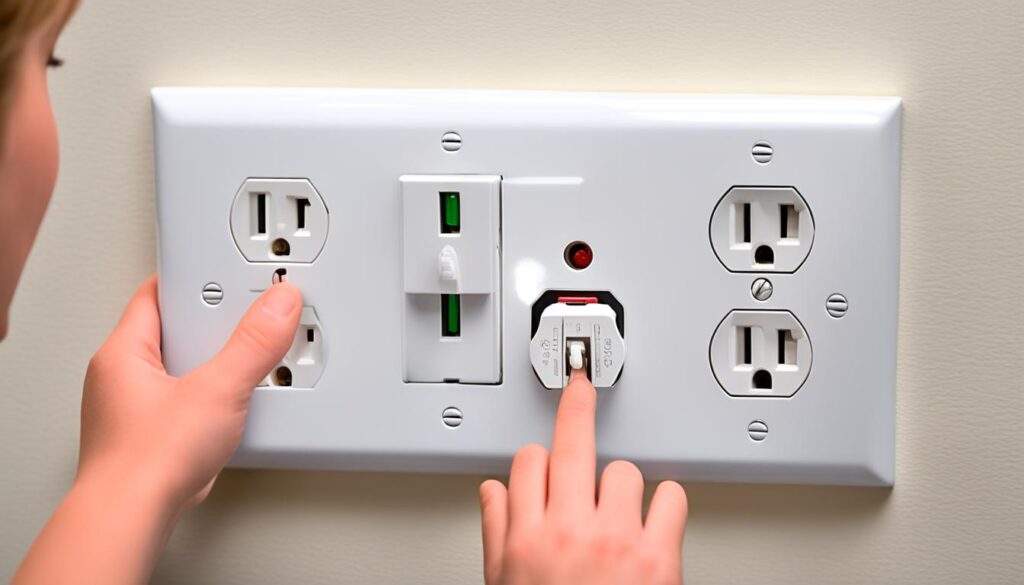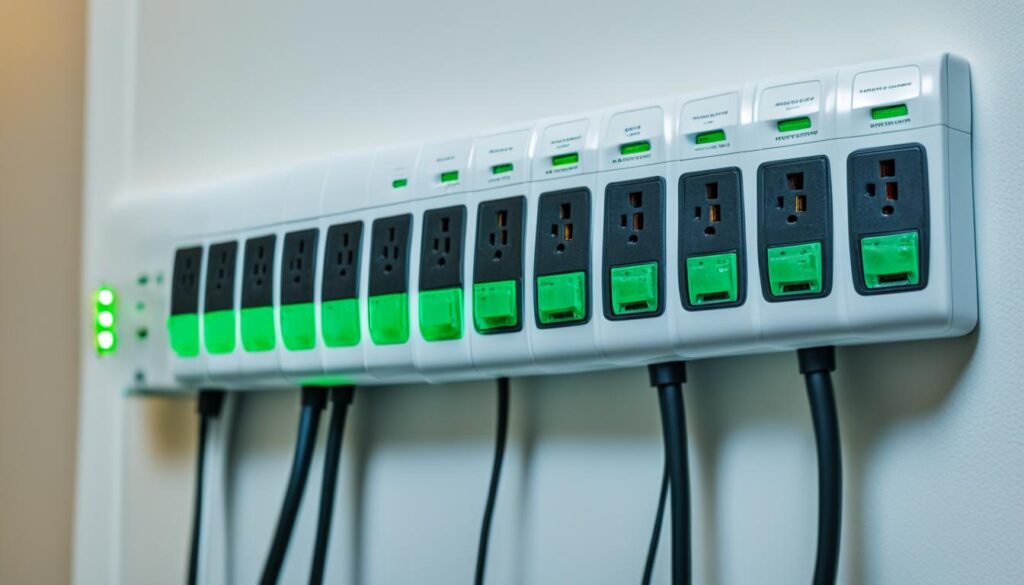When it comes to the safety and functionality of your home’s electrical system, paying attention to your electrical sockets is crucial. Faulty or outdated sockets can lead to potential hazards such as electrical shocks and fires. By following some essential tips, you can ensure the safety and efficiency of your socket outlets.
First and foremost, it’s important to avoid overloading your plug sockets. Overloading occurs when too many electrical appliances are connected to a single socket, straining the circuit and increasing the risk of overheating. To prevent this, distribute your devices across different sockets in your home and consider using power outlets equipped with surge protectors to safeguard against sudden voltage spikes.
Regularly inspecting your sockets and cords is another essential safety measure. Damaged cords with exposed wires can pose serious electrical risks, so it’s important to check them for any signs of wear and tear. Additionally, make sure to inspect your outlet covers regularly. Cracked or chipped covers should be replaced to prevent electrical accidents.
Childproofing your outlet receptacles is vital if you have young children at home. Plastic prong plugs can be used to cover unused sockets, preventing children from inserting objects or their fingers into them. Investing in childproof outlets can provide an extra layer of protection.
Lastly, it’s important to be aware of the power requirements and risks associated with different appliances. Some appliances, such as kettles, washing machines, and dishwashers, consume a significant amount of power. Plugging several power-hungry devices into a single socket can overload it, leading to potential hazards. Using twin-outlet plugs with caution is advised, as overloading one socket can be risky. Avoid using block adaptors without fuses, as they can increase the risk of fires.
By adhering to these safety tips and practicing responsible home maintenance, you can ensure the safety and reliability of your electrical sockets.
Key Takeaways:
- Avoid overloading your electrical sockets to prevent hazards.
- Regularly inspect cords for damages and replace them if necessary.
- Inspect outlet covers for cracks or chips and replace them if needed.
- Childproof your outlets to keep children safe.
- Be aware of the power requirements and risks associated with different appliances.
Updating Outlets and Checking Cords
Upgrading your electrical outlets is a crucial step in ensuring the safety of your home. By replacing outdated two-prong outlets with three-prong outlets or Ground Fault Circuit Interrupter (GFCI) outlets, you can significantly reduce the risk of electrical shocks and potential hazards.
GFCI outlets go a step further by actively monitoring the flow of electricity in a circuit. They can quickly detect any irregularities and immediately cut off power to the outlet, preventing electrical accidents. Installing GFCI outlets in areas prone to water exposure, such as kitchens, bathrooms, and outdoor spaces, is highly recommended.
Regularly checking cords for damages is another essential safety measure. Frayed or damaged cords can pose severe risks, including electrical fires and electrocution. Take the time to inspect cords for any visible signs of wear and tear, such as exposed wires or cracked insulation.
If you notice any damaged cords, immediate replacement is necessary. It’s better to be safe and invest in new cords than to risk potential electrical hazards.
Outlet covers also play a significant role in maintaining electrical safety. Inspect covers for any cracks, chips, or signs of damage. Damaged covers can expose the inner wiring of the outlet, increasing the risk of electrical shock or fire.
If you come across hot, burnt, or buzzing outlet covers, it’s crucial to contact a qualified electrician. These signs could indicate an underlying electrical issue that requires professional attention.
Outlet Safety Checklist:
- Upgrade outlets to three-prong or GFCI outlets
- Regularly check cords for damages and replace if necessary
- Inspect outlet covers for cracks, chips, or damage
- Contact a qualified electrician if covers are hot, burnt, or buzzing
By updating your outlets and staying vigilant in checking cords and outlet covers, you can create a safer electrical environment in your home.
| Common Signs of Damaged Cords: | How to Prevent Electrical Hazards: |
|---|---|
| Frayed or exposed wires | Regularly inspect cords for damages |
| Cracked or damaged insulation | Replace damaged cords immediately |
| Melted or charred areas on the cord | Use outlet covers to protect cords from physical damage |
| Loose connections between cord and plug | Avoid overloading outlets to prevent cord strain |
Preventing Overloading and Childproofing Outlets
To ensure the safety and efficiency of your home’s electrical system, it’s important to take measures to prevent overloading outlets and childproof them. By following these tips, you can minimize potential risks and create a secure environment for everyone in your household.
Avoid Overloading Outlets
One common cause of electrical hazards is overloaded outlets. When you plug in too many devices or appliances into a single outlet, it can lead to overheating, circuit breakers tripping, and even electrical fires. To prevent this:
- Use separate wall outlets for major appliances, distributing the electrical load evenly.
- Turn on only a few devices at a time to avoid overwhelming the circuit.
- Consider using energy-efficient LED or CFL bulbs, as they consume less power and reduce the strain on your electrical system.
Following these practices will help prevent overloaded outlets and keep your home safe.
Childproofing Outlets
Childproofing outlets is another important aspect of electrical safety, especially if you have young children in your home. Curious little hands can easily insert objects into uncovered outlets, risking electrical shocks or burns. To childproof your outlets:
- Place plastic prong plugs in unused outlets to prevent access by children.
- Buying these plugs in bulk ensures you have enough to secure all the outlets in your home, making it a cost-effective solution.
By taking these simple steps, you can significantly reduce the risk of accidents related to electrical outlets.

| Common Causes of Overloaded Outlets | Preventive Measures |
|---|---|
| Plugging multiple high-power appliances into a single outlet. | Use separate wall outlets for major appliances or consider hiring an electrician to install additional circuits. |
| Using extension cords to connect multiple devices. | Opt for power strips instead, which are designed to handle multiple devices safely. |
| Failure to distribute the electrical load evenly. | Make sure to spread out the devices across different outlets or circuits. |
By being aware of the common causes of overloaded outlets and childproofing them, you can ensure the well-being of everyone in your home.
Understanding Power Requirements and Risks
When it comes to the electrical safety of your home, understanding power consumption, overloaded plug sockets, and potential risks is crucial. Different appliances have varying power consumption levels, and being aware of this can help you avoid overloading your plug sockets and minimize the risk of electrical hazards.
Appliances such as kettles, washing machines, and dishwashers can use a substantial amount of power on their own. It’s important to factor in their power requirements and ensure that your plug sockets can handle them without becoming overloaded. Overloaded plug sockets can lead to overheating, short circuits, and even fires.

One common mistake that people make is using twin-outlet plugs without caution. While these may seem convenient, overloading one socket can be risky and increase the chances of electrical accidents. It’s always best to use them sparingly and consider the power demands of the devices you are connecting.
Another potential hazard is using block adaptors without fuses. These adaptors lack the necessary protection in case of electrical faults and can pose an increased fire risk. It’s recommended to avoid using block adaptors without fuses and opt for safer alternatives.
To safeguard your electrical devices from voltage spikes and fluctuations, surge protectors are highly recommended. Surge protectors act as a barrier between the power source and your devices, absorbing excess voltage and preventing damage. They are particularly useful in areas prone to power surges or lightning strikes.
By understanding power requirements, avoiding overloaded plug sockets, using caution with twin-outlet plugs, avoiding block adaptors without fuses, and investing in surge protectors, you can significantly reduce the risk of electrical hazards in your home.
| Appliance | Power Consumption |
|---|---|
| Kettle | 1,500-3,000 watts |
| Washing Machine | 500-2,500 watts |
| Dishwasher | 1,200-2,400 watts |
Conclusion
Prioritizing electrical safety in your home is essential to prevent hazards and ensure a safe living environment. By following the tips mentioned in this article, you can maintain the safety and efficiency of your electrical sockets. Regular inspections, proper usage of extension leads, and understanding power requirements are all part of responsible home maintenance. Take care of your electrical system to safeguard your home and loved ones.

